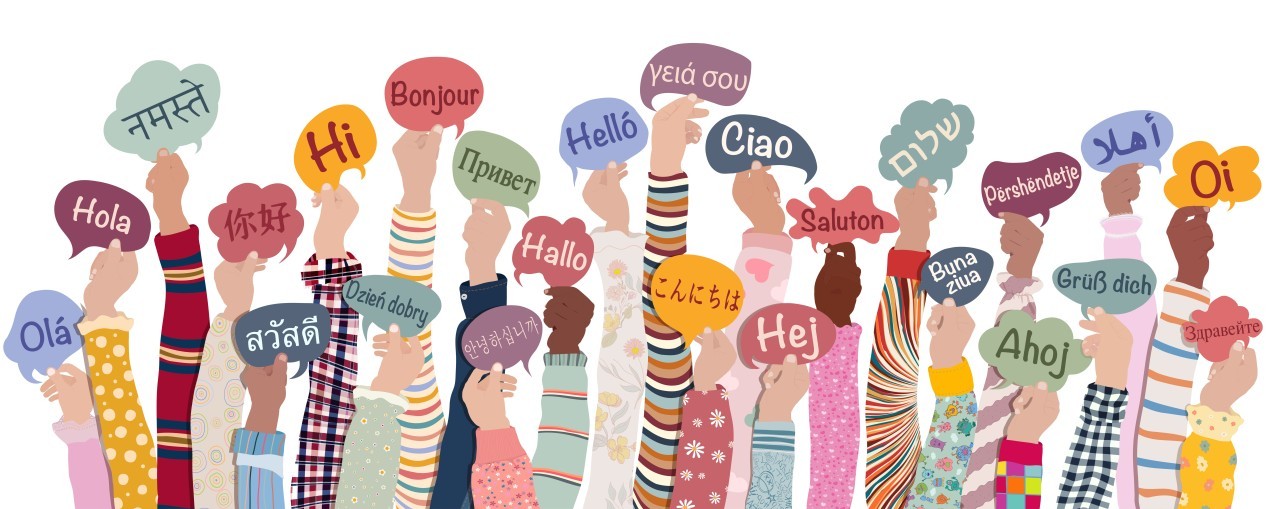近年、グローバル化が進むなかで「英語教育」の重要性がますます叫ばれています。確かに英語は世界共通語としての地位を確立しており、ビジネスや国際交流の場面で非常に役立つのは事実です。しかし、一方で「世界には英語以外にも多くの言語や文化が存在する」という当たり前の事実が、しばしば見落とされがちではないでしょうか。英語以外の言語に触れたり、その言語に根ざした文化を理解したりする体験は、子どもの視野をさらに広げ、国際感覚や多様な価値観を育むうえで大きな意味を持ちます。
本記事では、「なぜ英語以外の世界の言語と文化に触れることが子どもにとって有益なのか?」をテーマに、家庭でできる具体的な取り組みやメリットを探っていきます。「英語が苦手だから、ほかの言語なんて無理」と思う必要はありません。むしろ、英語以外の言語は、英語とは違う新しい好奇心の扉を開いてくれるかもしれません。さまざまな世界の言葉や文化に出会うことで、子どもは豊かな感性と柔軟な思考を身につけることができるのです。
1. 英語以外にも目を向ける意義
1-1. 多様な視点を得られる
世界には数千もの言語が存在すると言われています。英語は国際的に通じやすい言語ではありますが、特定の国や地域に深く入り込むときには、そこに根ざした言語や文化を理解することが何よりも重要です。子どもの頃から英語だけでなく、他の言語にも触れることで、「言語はコミュニケーションの手段であると同時に、文化や歴史、思考様式も体現している」という事実を実感できます。これは将来、海外の人々とより深いレベルで関わりたいときに大きな糧となるでしょう。
1-2. 異文化理解の一歩として有効
言語には、その言語を使う人々の価値観や習慣が多分に反映されています。たとえば、語彙や表現の豊富さから、その文化が何を大切にしているかが見えてくることもあります。英語以外の言語に触れることで、「ここではこんな言い回しがあるんだ」「こういう表現は日本語とはかなり違うな」と発見しやすくなります。こうした気づきは単なる語学力向上だけでなく、相手の文化的背景への理解にもつながるのです。
1-3. “マイナー言語”だからこそ得られる強み
英語に比べて学ぶ人が少ない言語をあえて選ぶと、将来的にユニークなスキルとして活かせる可能性があります。たとえばヨーロッパの小国やアフリカ・アジアの一部地域で使われる言語などは、学習者人口が世界的に少ないため、ビジネスシーンなどで需要と供給のバランスが崩れやすいのです。もちろん、子どもの将来を限定する必要はありませんが、「英語+もう一言語」の掛け算によって生まれる選択肢の広がりは、思わぬチャンスをもたらすこともあります。
2. 子どもにとってのメリット
英語以外の言語や文化に触れることは、単に「多言語が話せるようになるかもしれない」というだけではありません。以下では、子どもの成長において得られる主なメリットをいくつか挙げてみましょう。
2-1. 柔軟な思考力の育成
異なる言語を学ぶということは、異なる論理構造や表現体系に触れることでもあります。文法の組み立て方や言葉のニュアンスが日本語や英語とはまったく異なる言語に触れると、物事を考える枠組み自体が広がります。言語の学習は、ただ単に単語を覚えるだけでなく、「こういう考え方や価値観もあるんだな」と思考の幅を広げる訓練でもあるのです。これは、多様なバックグラウンドを持つ人々と協働するうえで欠かせない姿勢につながります。
2-2. コミュニケーションの幅が拡大する
世界には英語があまり通じない国や地域も数多く存在します。そうした場所へ旅行したり、ビジネスで関わったりするときに、その土地の言語を少しでも理解していると、現地の人々との距離が一気に縮まります。「挨拶程度しか話せなくても喜んでもらえた」というエピソードはよく耳にしますが、まさに言葉が持つ特別な“扉を開く力”を感じられる瞬間です。子どもの頃から複数言語に触れておくと、「言葉の壁」に対する抵抗感も減り、海外でのコミュニケーションがよりスムーズにできる可能性が高まります。
2-3. 自文化を見直すきっかけになる
他の文化や言語を学ぶと、逆説的に「日本語ってこんなに特殊だったんだ」「日本の習慣にはこういう意味があったんだ」という発見にもつながります。比較する対象が増えると、自分たちの当たり前に対して客観的な視点を持ちやすくなり、自国の文化をさらに誇りに思えるようになることも。日本の習慣や行事を海外の人に説明してみると、自分がいかに自国文化を理解していないかを痛感する場合もありますよね。子どもにとっては、こうした気づきこそが国際感覚を育む大きな第一歩となるのです。
2-4. 心の豊かさや創造力が育まれる
言葉は文化や芸術とも深く結びついています。たとえば、フランス語の歌やスペイン語の絵本、アラビア語圏の詩などは、それぞれの言語だからこそ生まれるリズムや表現の美しさを持っています。子どもがこうした多言語の音や文字、物語に親しむことは、感性や創造力を刺激する貴重な体験になるでしょう。音楽や文学、アニメや映画など、多彩なメディアをとおして「言語ならではの芸術世界」に触れることで、子どもの想像力の幅がぐんと広がります。
3. 家庭でできる多言語・多文化の取り入れ方
では、具体的に家庭で子どもが英語以外の言語や文化に触れる機会をどう増やせばいいのでしょうか。大げさに考える必要はありません。以下のような小さな工夫が、子どもにとっては大きな刺激となります。
3-1. 多言語の絵本や動画を一緒に楽しむ
子どもの好奇心をかき立てるには、まず興味を持ちやすいコンテンツから始めるのが効果的です。絵本やアニメ、童話などは、言語が多少分からなくてもビジュアルやストーリー自体で楽しめる場合が多いです。最近では、YouTubeや動画配信サービスで多言語の子ども向け番組を探すことも簡単になりました。「音が面白いね」「この言い方、英語と全然違うんだね」といった感想を共有するだけでも、子どもにとっては刺激的な体験になります。
3-2. 世界各地の音楽や芸術に触れる
先ほど触れたように、音楽や芸術作品は言葉の壁を越えて感情に訴えかけます。世界各国の民族音楽、伝統的な踊り、絵画、映画などに親子で触れてみると、子どもの感性が大いに刺激されます。たとえば小さい頃からサルサやフラメンコのリズムに馴染んだ子どもは、リズム感だけでなく「異文化への憧れ」や「もっと知りたい!」という知的好奇心を持ちやすくなるでしょう。
3-3. 言語を少しだけ“味わって”みる
「学習」と構えすぎずに、「今日はイタリア語で挨拶してみよう」「フランス語で数字を数えてみよう」といった軽いゲーム感覚で取り入れるのもおすすめです。子どもは遊びのなかで音をまねたり、面白い言い回しに笑ったりしながら、自然と言語に親しむものです。日本語や英語と発音が全然違う言語ほど、「なんだか面白い!」と笑いながら学べるかもしれません。
3-4. 多文化交流イベントやオンライン交流への参加
もし身近に国際交流イベントがあれば、ぜひ足を運んでみましょう。外国の料理を味わったり、伝統的な踊りを見たりするだけでも刺激を受けられます。また、近年はオンライン上で海外の子どもたちと繋がる機会が増えています。ビデオ通話やメッセージ交換を通じて、リアルタイムで異文化に触れられるのは大きなメリットです。こうしたコミュニケーション体験は、子どもの言葉への興味をさらに高めるきっかけになるでしょう。
4. 親が心がけたいサポートのポイント
子どもが英語以外の言語や文化に触れようとするとき、親のスタンスも非常に重要です。ここでは、親として押さえておきたいポイントをいくつか挙げます。
4-1. 間違いを楽しむ余裕を持つ
言葉を覚え始めると、子どもは必ず「発音が変」「文法がごちゃごちゃ」などの局面を経験します。そこで「正しく言いなさい」と叱ってしまうのではなく、「すごいね、そんな言葉も知ってるんだ!」と好奇心を認めてあげることが大切です。特に英語以外の言語は、親自身も知らないケースが多いでしょうから、子どもと一緒に「これはどう読むのかな?」とワクワクしながら学ぶくらいの姿勢でいると良いですね。
4-2. 「使えるかどうか」だけで測らない
外国語を学ぶとき、「将来役に立つかな」「テストの点数はどうかな」という評価軸に陥りがちです。しかし、子どもにとっては「その言語圏の文化を好きになった」「変わった音の響きが楽しかった」といった個人的な楽しみや喜びも立派な成果です。むしろ、好きになったり面白いと感じたりする気持ちこそが、学びを継続させるエンジンになります。
4-3. 自国文化とのバランスを取る
英語以外の外国語や文化に熱中するあまり、自国の文化をないがしろにするのは本末転倒です。他文化を学ぶことで自文化を見直すのは大切なプロセスですから、「日本の行事や伝統も一緒に楽しむ」バランス感覚を心がけましょう。日本の良さを実感していると、海外の人に自分の文化を紹介する楽しみも増え、一層グローバルな視点を持てるようになります。
まとめ
英語以外の世界の言語や文化に触れることは、子どもの「国際的なスキル」をただ増やすだけでなく、「豊かな思考力」「柔軟なコミュニケーション力」「自文化への再発見」など、様々な面で大きなメリットをもたらします。外国語の学習と聞くと、どうしても英語に意識が集中しがちですが、実は世界には魅力的な言語や文化が数多く存在するのです。
「英語が苦手だからほかの言語も苦手だろう」と早とちりする必要はありません。子どもの興味は予想外のところで芽生えることがあるものです。短いフレーズや歌から始めてもいいし、映像作品や音楽をきっかけに「こんな言語もあるんだ!」と盛り上がるだけでも十分な“入り口”になります。そこから自然に「もっと知りたい」「海外の友達を作ってみたい」という気持ちへ発展するケースも多いでしょう。
そして、何より大切なのは、子どもが持つ好奇心を親も一緒に楽しみながら、少しずつ知識や経験の幅を広げることです。多文化・多言語の世界に足を踏み入れるチャンスは、決して“特別”なものではありません。家庭のなかでほんの少し視点を変えるだけで、子どもたちの可能性は大きく花開くのです。英語だけにとらわれず、多言語の世界へ飛び込んでみましょう。その先にある無限の学びと豊かな交流を、子どもと一緒に体験してみてはいかがでしょうか。
Beyond English! The Benefits for Children of Experiencing Global Languages and Cultures
In recent years, the importance of English education has been emphasized more than ever as globalization advances. Indeed, English has established itself as a global lingua franca and is extremely useful in business and international exchanges. However, it’s easy to overlook a simple fact: “There are many languages and cultures in the world besides English.” Exposing children to languages other than English and the cultures shaped by those languages can greatly enrich their worldview and nurture their capacity to appreciate diverse values.
In this article, we explore why it’s beneficial for children to engage with global languages other than English, and we’ll look at practical ways families can bring these experiences into the home. There’s no need to think, “I’m not good at English, so learning another language is impossible.” Quite the contrary—diving into languages outside of English could open new doors of curiosity. By encountering various languages and cultures, children can develop a broad set of skills, including keen sensitivity and flexible thinking.
1. Why Look Beyond English?
1-1. Gaining Multiple Perspectives
It’s said that there are thousands of languages worldwide. While English is indeed widely understood, when you want to truly immerse yourself in another culture, nothing beats knowing the language that is deeply rooted in that region. From a young age, exposing children to not only English but other languages as well teaches them that “a language is not just a tool for communication but also a reflection of culture, history, and ways of thinking.” This can be a valuable asset if they ever seek deeper connections with people around the world.
1-2. A First Step Towards Intercultural Understanding
Language often reflects the values and customs of the people who speak it. By learning expressions and vocabulary in other languages, children get a glimpse of what those communities hold dear. Observations like “They have a phrase for this concept—something that doesn’t exist in Japanese” or “Their way of saying this is so different from what we’re used to” can lead to greater awareness of cultural backgrounds, not just linguistic proficiency.
1-3. The Advantage of “Minor Languages”
Opting to study a language with fewer global learners might lead to unique future opportunities. For instance, languages spoken in smaller European nations or certain parts of Africa or Asia might be in short supply among learners, but high demand in specific business or social settings. There’s no need to predetermine a child’s future path, but “English plus one more language” can open unexpected possibilities.
2. Benefits for Children
Learning and experiencing languages and cultures beyond English isn’t only about the possibility of becoming a polyglot. There are also several key advantages for children’s development:
2-1. Developing Flexible Thinking
Exploring a different language means engaging with a new logical and expressive system. Grammar structures and nuances can be radically different from Japanese or English, and this can broaden the way children think about the world. Language study isn’t just about memorizing words; it’s about training the mind to recognize multiple ways of viewing and valuing experiences. This mindset is essential when collaborating with individuals from diverse backgrounds.
2-2. Expanding Communication Options
Many parts of the world have limited English proficiency. Whether traveling or doing business, knowing even a little of the local language can break down barriers and foster immediate closeness. People often say how locals’ faces light up when a visitor attempts even a simple greeting in their language. Children who grow up exposed to multiple languages may be more comfortable with unfamiliar linguistic environments, leading to smoother communication in multicultural settings.
2-3. Gaining New Perspectives on One’s Own Culture
Learning another language and culture can paradoxically help children rediscover the uniqueness of their own language and customs. With more points of comparison, they’ll view what was once “normal” from a fresh, more objective perspective. For example, they may realize how special the Japanese language is or recognize the deeper meaning behind certain Japanese traditions. Children who experience these kinds of “aha” moments often take their first big step toward true international awareness.
2-4. Fostering Emotional Richness and Creativity
Language is intimately connected to culture and the arts. French songs, Spanish picture books, Arabic poems—each has its unique charm stemming from the language itself. For children, being exposed to the sounds, scripts, and stories of many languages can be a source of awe and inspiration. Whether through music, literature, animation, or film, experiencing “the art only made possible by a particular language” can greatly expand a child’s imagination.
3. Practical Ways to Introduce Multiple Languages & Cultures at Home
How can families create more opportunities for children to experience languages and cultures other than English? It doesn’t have to be a grand endeavor. Here are a few simple ideas that can spark big curiosity in children:
3-1. Enjoy Multilingual Picture Books and Videos Together
One of the best ways to stir a child’s curiosity is to start with something fun. Picture books, cartoons, and fairy tales often rely on visuals and narrative elements that can be enjoyed even with limited language comprehension. These days, it’s easy to find children’s programs in multiple languages on YouTube or streaming services. Merely sharing reactions like “That sound is so interesting!” or “This expression is totally different from English!” can be an exciting experience for a child.
3-2. Explore Music and Art from Around the World
Music and art transcends linguistic barriers and appeals directly to our emotions. Listening to folk music from different cultures, watching traditional dances, or admiring paintings and films from various countries can deeply influence a child’s creativity and curiosity. A child who becomes familiar with salsa or flamenco rhythms at a young age might develop not just a sense of rhythm but also an “intrigue for other cultures” that fuels further exploration.
3-3. “Sample” a Language Without Overcommitting
Instead of turning it into a formal “study” session, try fun language games at home. For example, “Today let’s greet each other in Italian” or “Let’s count to 10 in French.” Children learn naturally by mimicking sounds, laughing at funny expressions, and generally playing with language. Sometimes languages that differ greatly from Japanese or English can trigger a sense of humor and fascination—“It sounds so strange and fun!”
3-4. Participate in Multicultural Events or Online Exchanges
If there are international exchange events nearby, by all means take your child to experience foreign cuisines or watch traditional dances. Such encounters can leave lasting impressions. Nowadays, more opportunities exist to connect with kids overseas via online platforms, where real-time video calls or messaging can provide a direct multicultural experience. These meaningful interactions often enhance a child’s enthusiasm for languages.
4. Tips for Parental Support
Parents play a vital role in encouraging children to explore languages and cultures outside English. Here are some key points to keep in mind:
4-1. Embrace Mistakes with Enthusiasm
When children start experimenting with a foreign language, they will inevitably stumble—mispronouncing words or mixing up grammar. Rather than scolding them for mistakes, applaud their curiosity: “That’s amazing! I can’t believe you learned that word!” Especially with non-English languages that parents themselves may not know, it’s great to maintain a shared sense of excitement—“Hmm, how do we pronounce this together?”
4-2. Don’t Focus Solely on Practicality
It’s easy to worry about whether a new language “will be useful in the future” or “will help with test scores,” but children often gain great satisfaction simply from enjoying the language: liking its cultural atmosphere, the amusing sounds, or discovering new words. That passion often becomes the engine for continued learning, far more important than any short-term metrics.
4-3. Balance with Appreciation for One’s Own Culture
Be sure not to neglect your own culture in the excitement of exploring foreign ones. Learning about other cultures should also encourage reevaluation of your own. Celebrating local traditions and events alongside global ones helps children realize the value of both. That way, they can confidently share their own culture with others and further cultivate a global perspective.
Conclusion
Experiencing languages and cultures beyond English not only builds a child’s “international skill set” but also expands their thinking, creativity, ability to communicate, and respect for their own culture. While English often takes center stage, there are countless fascinating languages around the globe, each with its unique cultural tapestry.
Don’t assume “If we’re not good at English, we can’t possibly tackle another language.” Children’s interests often sprout from unexpected places. Even learning a single phrase or song can be an excellent starting point, sparking a moment of discovery—“I never knew this language existed!” This spark can naturally evolve into “I want to learn more” or “I want to make friends in other countries.”
Most importantly, parents can nurture these sparks by sharing in the joy of discovery and gradually expanding their child’s knowledge and experiences. Venturing into the world of multiple languages and cultures is not some exclusive privilege; a simple shift in perspective in daily life can unleash a child’s potential. Why not step beyond English and explore the world of many languages? Together with your child, you can experience the endless learning and meaningful exchanges that await.




コメント